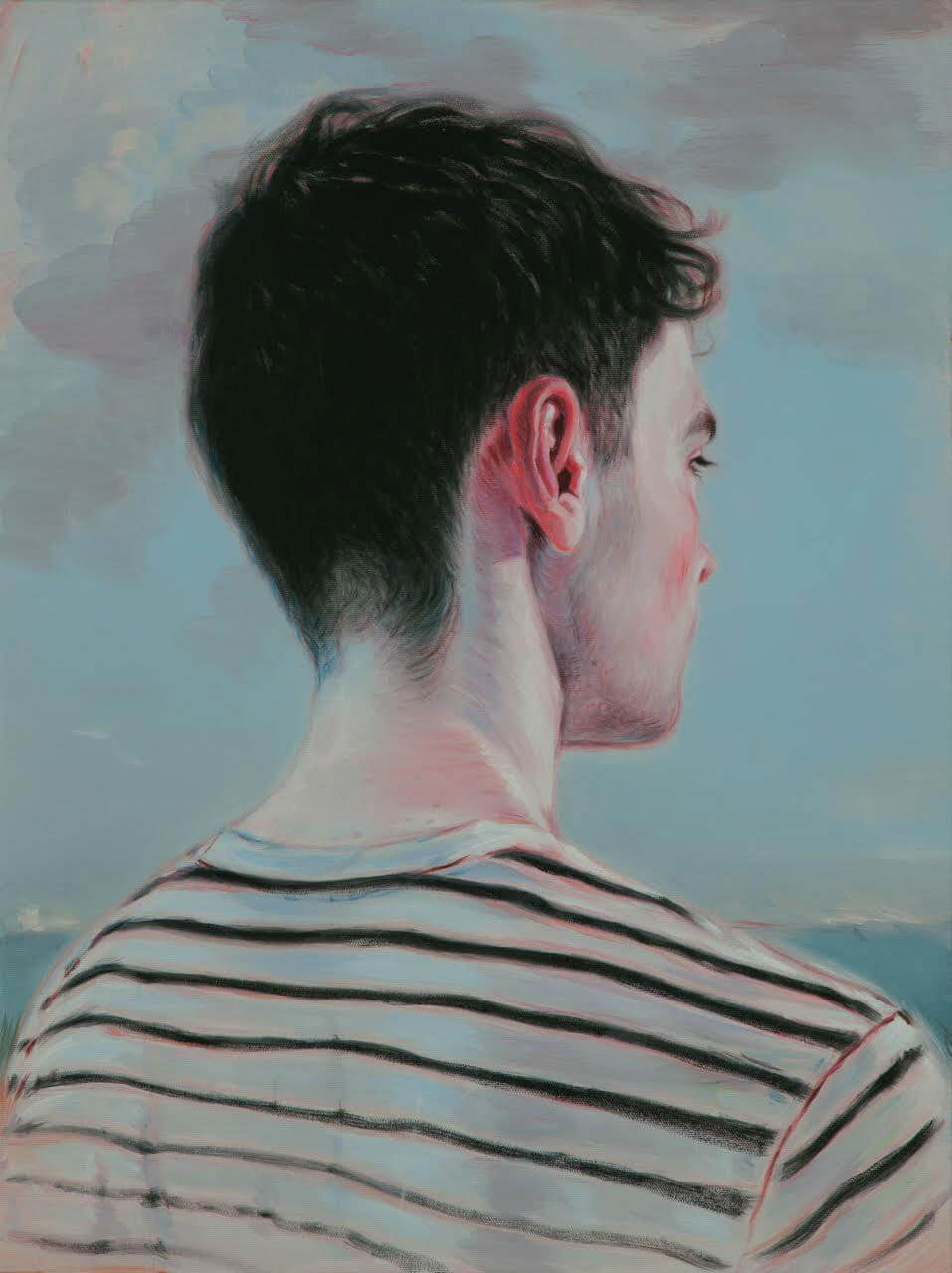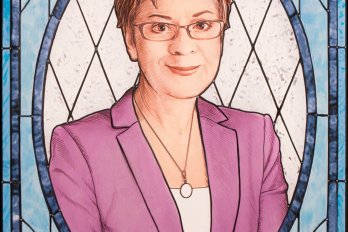Toronto artist Kris Knight paints beautiful androgynous men in a soft pastel palette that’s mixed with patches of greyer hues reminiscent of decay. His works could easily descend into schlock, because they’re almost too attractive. But they evoke a slight unease that saves them from being saccharine—a hint of the sinister. His subjects often look away, like children ashamed of being caught in a lie. Some stare you down like cornered foxes. Some wear tiaras of melting candles. It’s prettiness with nerve.
Knight is the most celebrated member of a young Toronto crew that’s creating compelling portraiture in a digital age. He’s just now, at thirty-five, achieved a self-sustaining art career—he no longer works in a Mexican restaurant or at an eyewear boutique. Last year, he showed his work in Paris, San Francisco, and Toronto, and at Miami’s Art Basel. A year before, he had a breakout moment when Gucci tapped him to paint a mutated version of the brand’s classic floral print that Vogue editor-in-chief Anna Wintour would later wear. In December, for the first time in about a decade, he took a few weeks off. (A self-described workaholic, he spent much of the time cleaning his apartment.) Now he’s back in the studio, preparing for yet another high-profile show—this one in Paris—which means he’s staring at canvas fourteen hours a day.
Despite the success, Knight is a grounded guy. He apologized, before our interview, for being a nervous person. He answers questions carefully, as if smoothing out the wrinkles of his anxious thoughts. He’s been pursuing his craft since he was four or five and early on chose to paint faces exclusively. “They’re the only things I’m inspired by,” he says.
As a child, Knight was obsessed with the guillotine scenes in Napoleon and Josephine, a late-’80s TV miniseries. His colours come from watching his baker mother ice cakes, but also from the gaudy portraiture of the French Revolution. He attended high school in Ridgetown, Ontario, and his teenage years were filled with closeted boys he covertly dated in southwestern towns around Windsor: “We would have relationships in the shadows—we’d meet up in forests, we’d meet up in fields, we’d take bus trips—and it was all about being a teenager and having early loves, but all through lies and secrets.” Out of a combination of these young lovers, cakes, and executions emerges an unsettling harmony of sex, indulgence, and foreboding.
At nineteen, Knight moved from Ridgetown to Toronto, where he attended OCAD University. There, his style evolved from a vivid comic-book palette to a delicate, beguiling counterpoise. But his core obsession—the eerie-pretty subject—remained the same. He paints mostly on small canvases he holds on his lap. He’s often working on six at a time: while the oil dries on one waif’s cheekbones, he’s illuminating the eyes of another. He cuts much of his work to ribbons with a razor after he decides it’s not good enough. “When I’m painting for a long time,” he says, “I forget that I’m painting, and that’s when I start daydreaming. My brain is just a synthesis of fantasy and memory—I’m thinking about all these stories, and those stories turn into these paintings.”

Being a portraitist is tricky in the smartphone era. Our faces are everywhere, and so are data plans. Photography is now omnipresent. Of necessity, artists have employed techniques that make a portrait more than just a record—distortions that skew the subject, conveying personality and psyche through exaggeration and imprecision. Sometimes, as in Swiss painter Paul Klee’s Senecio—a cubist rendering of an old man going senile—the artist leaves more skew than face. It’s that sensibility that makes busts of the Stoics look stoic, or, pushed much further, makes the French Dadaist Marcel Duchamp’s Nude Descending a Staircase look like a washing machine falling apart.
Meanwhile, Knight takes his inspiration from the luxurious works of nineteenth-century portraitist John Singer Sargent and eighteenth-century painter Thomas Lawrence, in which he sees traces of “a rich darkness.” He also draws on elements of rococo painters such as Jean-Antoine Watteau and Jean-Honoré Fragonard. “It’s beautiful work,” he says, “but there are cracks in it.” Knight’s approach focuses on that darkness directly—relentlessly pursuing an aesthetic that is both brittle and ethereal.
If you still make strictly realist portraits—if you’re Canadian painter Phil Richards, for instance—I’m not mad at you. The world loses nothing by having Richards’s stunningly executed, utterly mundane picture of the Queen in it. But that work displays a kind of naïveté; it feels nerdy and stagnant.
Knight’s compatriots—the crop of Toronto artists pushing the bounds of traditional portraiture—have similarly troubled, mocking relationships with the mainstream. Shary Boyle gleefully chops up portraits into bright pieces; in one porcelain figurine, for example, an elegant lady’s body is replaced by a grotesque column of lovely heads. Stephen Appleby-Barr paints a fantastical nineteenth-century Europe in which severe rabbits contemplate conquering the New World. In other works, soldiers depart for brutal wars wearing ridiculous hats. (If I were in art school hankering for a good grade, I’d call his work a sly commentary on the romanticization of antiquated hegemonies.) Margaux Williamson’s work feels secretive and sacred. Looking at her paintings, one feels as if one were rummaging through the possessions of a strange imagination. In one piece, she and Leonardo DiCaprio are homeless buddies. In another, her partner has a blurred-out face. Charles Bierk creates portraits indistinguishable from photographs. It’s classic work that draws its full significance from the age of the lens.
Knight’s relationship with this form is subtler—he’s trying to capture something more essential than satirical. His paintings look a little like everything we’ve seen before, from lounging models in Vogue to plump-lipped Fayum mummy portraits, and yet they have a feel distinctly their own. “It needs to have a little bit of grit,” Knight says, “but in a way that’s not obvious.”
He’s right—it’s not obvious. Having spent hours with his paintings, I still don’t feel as if I totally understand what’s going on. Of course, part of what makes a good painting is a sense of mystery. If you begin talking about the magnetism of almost-clashing colours, you’re probably about to be boring. A painting so bland it could be described perfectly isn’t worth writing about, or painting.
Part of the intrigue of Knight’s work—what you can’t shake—comes from the sense that his subjects have been caught there on the canvas by accident. It’s like looking at a caged animal: the joy is marred by a feeling of voyeurism. You want the subjects in his paintings to seek out the privilege of your gaze. But, really, you’re an intruder. In their company, you’re alone in your longing.
This appeared in the May 2016 issue.





